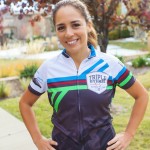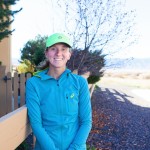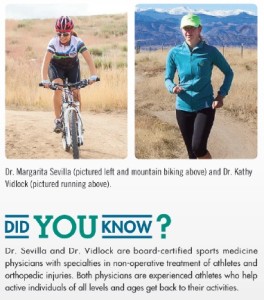Pure View | by

Athlete-Doctors Aid Coloradans in Competition and Active Lifestyles
A 19-year-old triathlete collapses at the finish line, and the race’s medical team rushes him to the emergency tent. With her patient radiating a 108-degree body temperature, Dr. Margarita Sevilla dips the athlete up to his neck in an ice bath. In seven minutes, his temperature drops a mere 5 degrees, and an ambulance rushes him to the hospital (covered in ice towels, AC blasting). Fortunately, the racer is stabilized and spends a week in the ICU recovering from a diagnosed heat stroke. His kidneys had shut down, and he likely would have died if not for the quick care of the sports-focused medical team.
It’s all in a day’s work for Sevilla, who, as a sports medicine physician at Lone Tree’s Peak Orthopedics & Spine, brings a unique style of care to the area as an athlete and a specialist. She and another fellow athlete and orthopedic physician, Dr. Kathy Vidlock of Colorado Orthopaedics in Lone Tree, have both studied and, sometimes, experienced the issues their patients face.
Unique Care For Colorado’s Athletes
Though an extreme case, heat stroke isn’t uncommon in endurance races, Sevilla says of the teenager’s case. Unusually hot days, coupled with dehydration, can push an athlete’s self-cooling mechanisms over the edge, no matter their age. In fact, heat-related deaths among American Interscholastic Football players have nearly tripled to almost three per year since the mid-1990s, according to a 2014 University of Georgia study. Even the U.S. Air Force’s 59th Medical Wing recently partnered with the Korey Stringer Institute to help improve heat-illness protocols for military trainees in San Antonio.
“The biggest factor for participants is to listen to their body—on a hot day, maybe that means go a slower pace or stop,” says Vidlock, who completed her Sports Medicine Fellowship at the University of Iowa and worked as an Iowa Hawkeyes team physician. Vidlock, a runner, joins medical teams for endurance races. She also clipped her first 50K last September in Colorado’s Bear Chase Trail Race.
For medical teams, it’s as equally important for the rescue procedures to be nailed down as it is for athletes to train and hydrate. Staff instruction is essential, says Sevilla, who has been the medical director for Life Time Fitness races and joined the medical crew at the Ironman World Championships in Kona, HI, eight times. She’s also completed 10 Ironman Triathlons—in a decade’s time—which, as with Vidlock, lends a unique lens in providing health care for athletes, in a race or in clinic. For instance, that cross-experience helps Sevilla strategize the spotter locations for open water swims, as accounting at all times for each bright swim cap is critical. In eight years, there were 45 fatalities in triathlon events—30 of those deaths occurred during the swim leg, according to the 2012 USA Triathlon Fatality Incidents Study.
 Injury Prevention
Injury Prevention
Among patient visits, both physicians treat male and female athletes across the age spectrum. The most common cases include arthritis in aging athletes, tennis elbow and rotator cuff tears for adults, and amongst high schoolers, concussions and ligament tears in impact sports, such as rugby and soccer.
Overuse injuries have also increased in high school, due to athletes playing the same sport year-round, Vidlock says. Stress fractures are a prime example, which result from repetitive impact training, common in gymnasts or runners. In 2008, Vidlock experienced a stress fracture after upping her mileage too quickly. Now, she pays closer attention to her training log, she says. “Don’t increase your running mileage by more than 10 percent per week,” she says. “And make sure you eat recommended allowances of Vitamin D and calcium.” Underweight athletes—especially those bearing pressure to be thin, such as runners and gymnasts, are the most susceptible populations. Medical studies also reflect a greater incidence of stress fractures in females, which can also be an interplay of three conditions referred to as the Female Athlete Triad: disordered eating, amenorrhea, and osteoporosis.
Among women, ACL injury rates tend to be higher than their male counterparts, particularly in soccer. In a 15-year period, the rate of ACL tears was three times higher in NCAA women’s soccer than in the men’s, according to The American Journal of Sports Medicine. To help prevent ACL tears, as well as other sports injuries, one progressive tool at Peak Orthopedics & Spine is the DARI (Dynamic Athletics Research Institute) software: a nine-camera, 3D-motion analysis—the only one in Colorado—that’s already been used by NHL, NFL and CU Dance Team athletes.
But the single-best preventative measure for sports injuries, across the board, remains old school: Maintain core strength, agreed both physicians. “Keep your lower abdominal and buttocks muscles strong and your injuries, overall, are going to be a lot less,” Vidlock says.
Leave a Comment
Please be respectful while leaving comments. All comments are subject to removal by the moderator.



